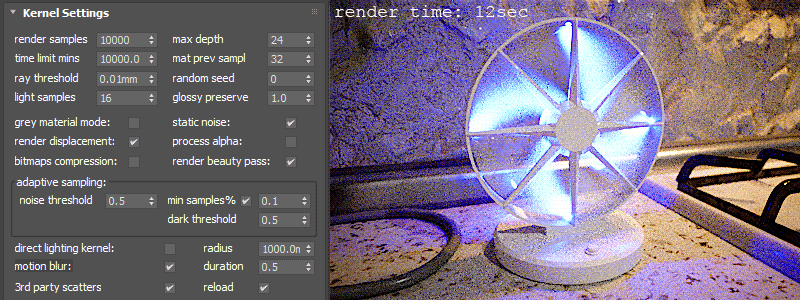KERNEL SETTINGS

render samples set maximum possible samples number for image rendering. Higher value gives less noise, but slower rendering.
time limit set maximum render time for production render. RT render ignores time limit.
max depth set maximum ray bounce. High value gives more correct render view but reduces render speed. Low value makes render image darker and cause black artifacts on reflections and refractions. 
light samples value should be increased in case of many light sources. It gives much less direct lighting noise but slightly reduces render speed.
ray threshold is the distance to offset new rays to avoid an intersection with the same geometry. Too high value may cause holes in geometry. To low value may cause artifacts. 
material preview samples sets material preview quality in material editor slots.
process alpha turns frame buffer alpha channel on and cuts the environment.
static noise means noise pattern will not change from frame to frame during animation. This is a good way to avoid noise flickering. On complex light reflections or fast animation it may not work with 100% accuracy.
glossy preserve limits reflections/refractions brightness. Low values dim highlights and, reduced reflections/refractions noise.
bitmap compression compress every bitmap texture unless fstorm bitmap texture has no compression option. Everage compression rate is about 4 times (four times more bitmap textures can be fitted to gpu memory) with no visual artifacts and very small (about 5-10%) speed drop. Bitmap compression may not working properly with bump mapping in some cases. In such cases it is recommended to set no compression option for certain fstorm bitmap texture used for bump mapping.
gray material mode replaces all material with simple gray material. It keeps original material emission, opacity and bump mapping. It allows to pass direct light through initially transparent materials.
render beauty pass can be switched off in case of only render elements rendering to speed up the process.
render displacement can be switched off as a fast way to get rid of all displacement in the scene in testing purposes..
adaptive sampling controll noise over the picture and balance between noise and render time.
noise threshold sets general image noise level. Render engine stops sampling pixels with lower noise level and concentrates on pixels with higher noise level. 
min samples% sets initial sampling rate before adaptivity starts working. It is necessary to estimate initial noise level. Too low values may result in details loss due to incorrect noise level measurement. Too high values decrease adaptivity strength and render speed. If option is not set, automatic value is used.
darkness threshold controls noise level in dark areas. If some image parts are too dark to see any noise there, then there is no reason to keep noise on low level, it is almost invisible anyway. Low values decrease noise in dark areas and increase rendering time.
direct lighting kernel is a mix between pathtracing and ambient occlusion. This kernel is less realistic but faster than pathtracing.
on turns on direct lighting kernel.
radius sets a radius of ambient occlusion part. Less radius makes ambient occlusion part stronger.
motion blur sets global motion blur setting.
on turns on/off motion blur globally.
duration sets motion blur duration in frame duration units.
Object Motion Blur should be activated, otherwise camera motion blur will be active only.
3rd party scatters option can switch off and on support of Forest Pack and MultiScatter. Reload option means scatters recompile geometry every frame during animation, if this option is not set, scatters recompile geometry only once before animation.
render mask allows to render only specific object visiblie in reflections and refractions with alpha with significant speedup comparing with a whole image rerendering.
objects can be specified via object ids or via exclude/include list.